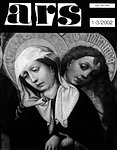
Časopis ARS 35 (2002) 1-3
Štúdie
Štefan ORIŠKO: K počiatkom románskeho kameňosochárstva na Slovensku (Najstaršie pamiatky, problémy výskumu)[The Beginnings of Romanesque Stonemasonry in Slovakia (The Oldest Monuments and Research Problems)], s. 3-48, 29 obr.
Resumé
Ivan GERÁT: Ikonografická tradícia a význam obrazu: alžbetínsky cyklus na hlavnom oltári košického dómu[Ikonographische Tradition und Bildbedeutung: Elisabethzyklus am Hauptaltar des Kaschauer Doms][Iconographic Tradition and the Meaning of an Image: Elizabethan Cycle of the High Altar in the Košice Cathedral], s. 49-96, 43 obr.
Resumé
Mária NOVOTNÁ - Anna SVETKOVÁ: Smrť Panny Márie. Tabuľová maľba zo Spišského Štvrtku[Tod Mariens. Ein Tafelbild aus Donnersmark/Spišský Štvrtok][Death of the Virgin. Table Painting from Spišský Štvrtok], s. 97-110, 7 obr.
Resumé
Ivo HLOBIL: Rytířské náhrobníky rané renesance na Slovensku a Moravě[Die Ritter-Denkmäler der Frührenaissance in der Slowakei und in Mähren][Knights’ Tombstones of the Early Renaissance in Slovakia and Moravia], s. 111-125, 18 obr.
Resumé
Zuzana LAPITKOVÁ: Ikonografické súvislosti slávobrán pre slovenské banské mestá (rekonštrukcia výtvarnej podoby na základe dobového opisu)[Iconographical Content of Triumphal Arches for Slovak Mining Town (Reconstruction of Their Art Visuality on the Basis of the Written Documents)], s. 126-134, 4 obr.
Resumé
Barbara BALÁŽOVÁ: Stĺp Najsvätejšej Trojice v Kremnici (1765 – 1772). Jeden z posledných morových stĺpov v bývalých habsburských krajinách[The Plague Column of the Holy Trinity in Kremnica (1765 – 1772). One of the Last Plague Columns in the Former Habsburg Empire], s. 135-184, 29 obr.
Resumé
Sonja ŽITKO: Das Grabdenkmal als Hommage und die europäische Friedhofskunst von der Mitte des 19. Jahrhunderts bis zum Beginn des I. Weltkrieges am Beispiel der Slowenen[Náhrobok ako hommage a európske umenie cintorínov od polovice 19. storočia do začiatku I. svetovej vojny na príklade Slovincov][Tombstone as a Homage and the European Cemetery Art from the Middle of the 19th Century to the Beginning of World War I Exemplified on Slovenes], s. 185-199, 7 obr.
Resumé
Udo KULTERMANN: Ein Unendliches in Bewegung – Museen für Zeitgenössische Kunst?[Nekonečné v pohybe – múzeá pre súčasné umenie?][Endless in Motion – Museums for the Contemporary Art?], s. 200-212
Resumé
Petra HANÁKOVÁ: Teoretická kritika (modernistického) múzea umenia – exemplárny terč newyorské MoMA (The Museum of Modern Art)[Theoretical Critique of (Modernist) Museum of Art – an Exemplary Target New York's MoMA (The Museum of Modern Art)], s. 213-233, 7 obr.
Resumé
Mária ORIŠKOVÁ: New Grand Narratives in East-Central European Art History?[Nové „veľké rozprávania“ v stredoeurópskych dejinách umenia?], s. 234-240, 4 obr.
Resumé
Materiály
Ivan GERÁT: Zriedkavá téma zo života sv. Martina v Čeríne[Unusual Theme from the Life of St. Martin in Čerín], s. 241-243, 1 obr.
Bibiana Pomfyová: Spišská sakrálna architektúra 13. storočia. K problému počiatkov gotiky na Slovensku. Bratislava 2001. (Obhajoba dizertačnej práce)[Bibiana Pomfyová: Sacral Architecture of the Spiš Region in the 13th Century. On the Issue of the Beginnings of the Gothic in Slovakia. Bratislava 2001. (Dissertation Defence)], s. 244-257
Martin Vančo: Centrálne stavby veľkomoravskej ríše. Bratislava 2001. (Obhajoba dizertačnej práce)[Martin Vančo: Central Buildings of the Great Moravian Empire. Bratislava 2001. (Dissertation Defence)], s. 257-279
Recenzie
Mária ORIŠKOVÁ: Niekoľko poznámok ku knihe S. A. Mansbacha „Modern Art in Eastern Europe: From the Baltic to the Balkans, ca. 1890 – 1939“[Several Remarks on the Book “Modern Art in Eastern Europe: From the Baltic to the Balkans, ca. 1890 – 1939” by S. A. Mansbach], s. 280-299, 7 obr.
Resumé